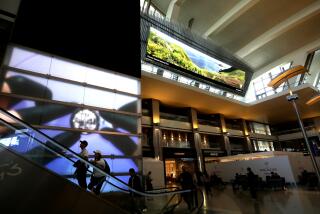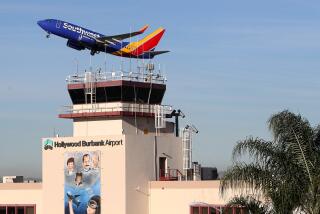Theoretically a Great Idea for Passengers and Airlines : Competing Carriers Can Break Down the Hub
Theoretically, an airport hub is a great idea for airlines and passengers. Theoretically.
It allows for a smooth, streamlined approach to connecting flights. It saves time for passengers and money for airlines, allowing each airline to virtually feed itself with passengers from its own planes connecting from somewhere else.
In markets where one airline dominates a particular hub--Northwest Orient in Minneapolis, USAIR in Pittsburgh, Piedmont in Charlotte--the operation works well.
And in less congested hubs like Kansas City and Memphis, the operation works very well. Passengers can make their onward flights with minimum connection times.
But when the hubs become congested--when airlines begin to compete for control of one hub--things quickly degenerate. Often, the entire system can break down. And, all too often, the result is a passenger nightmare of airport gridlock.
Delays Have Become Legend
The stories of airline delays have become legend. As a result, some frequent travelers have said that when they die, they’ll have to connect through Atlanta.
To be sure, Atlanta’s Hartsfield Airport--the country’s second-busiest--has become notorious as an overloaded hub.
The competition for scheduling in Atlanta between Eastern and Delta airlines has often resulted in long delays and angry passengers.
It is not unusual for 24 planes of the two carriers to be scheduled to take off from or land at Atlanta at the same time--a physical impossibility.
“It’s a scheduling game of chicken,” said one airline official, “and no one wants to blink.”
In fact, when talks about rescheduling some of these Atlanta flights were held recently, Delta representatives walked out. (The federal Department of Transportation is considering enforcement action against both airlines for alleged unfair and deceptive flight scheduling in Atlanta.)
Better in Detroit--Slightly
The situation is only slightly better at Detroit’s Metropolitan Wayne County Airport. Northwest Orient Airlines, which took over Republic Airlines last fall, has 237 daily departures out of Detroit.
A recent hub performance survey revealed that one-third of Northwest Orient’s flights were delayed 30 minutes or more, and only 40% of Northwest Orient’s departures were within 15 minutes of schedule.
Although the airline claims improved performance, the Detroit example is a good one: If Northwest Orient doesn’t reschedule some of its flights, the situation could get worse.
Some airlines have reworked their timetables. American has rescheduled more than 1,000 of its flights. United has rescheduled 400.
But in some areas, the best way to ease delays is to start a hub.
That’s what Eastern Airlines did last November when it established a major hub in San Juan, Puerto Rico, with 24 daily flights linking U.S. cities with seven islands in the lower Caribbean.
Major Expansion
The hub represented a major expansion of service in the area, with Eastern and Eastern Metro Express operating 144 flights in and out of San Juan each day.
The San Juan hub was also linked with Eastern’s existing Miami hub.
American also established a Caribbean hub in San Juan.
“Before we did this,” said Eastern spokesman Joe Scott, “San Juan was nothing but a loose connecting affiliation of airlines.”
As a result, it was not unusual for passengers connecting in San Juan for other Caribbean islands to be confronted with long waits between flights, mishandled baggage and other operational delays. In some cases, connecting times were so bad that passengers had to stay overnight in Puerto Rico.
Not anymore.
‘A Natural Hub’
“San Juan is a natural hub for the Caribbean,” Scott said. “It’s the major terminal. And now, we can not only coordinate schedules that actually connect within reasonable times, but we can make efficient use of smaller aircraft.”
And, because Eastern passengers are connecting to Eastern planes, fewer bags are being lost.
“It takes one step out of the baggage process,” Scott said. “Before, if a passenger’s bag was lost, it could have been done by any number of airlines. Now if a bag is lost, we have a better chance of locating it, and faster.”
The Eastern Airlines hub in San Juan seems to work. So does the Pittsburgh hub of USAIR.
“A well-working hub is the key to an airline’s success,” said Edwin Colodny, chairman of USAIR. “A hub allows your schedule to increase the frequency of connecting opportunities for passengers.”
But a hub doesn’t work if baggage isn’t transferred efficiently. Last year, Colodny hired a consultant to study how the bag transfer system worked at the Pittsburgh hub.
‘Big Bucks’ to Lose Bags
“We wanted to know everything about the movement of passenger bags,” he said. “Where and when it comes off the airplanes, how fast it’s picked up, how fast it’s delivered and how it impacts our work force. It’s big bucks to deal with mishandled baggage at hubs, not to mention the incredible inconvenience to our customers.”
In Pittsburgh, USAIR had a good on-time performance record. No surprise there. After all, USAIR controls 33 gates and 82% of the flights in and out of Pittsburgh. Each day 279 USAIR flights operate in and out of Pittsburgh.
“But,” said Wayne Barnett, USAIR’s assistant vice president of customer service, “we had a terrible reputation for mishandling bags.”
The airline had sufficient staff to do the job, and enough equipment--150 tractors pulling more than 500 baggage carts. But somehow, the system was getting clogged and baggage was missing connections.
Two years ago the airline mishandled 30 bags per 1,000 in Pittsburgh, a very high number.
‘Unacceptable to Us’
“That figure was unacceptable to us,” said Ralph Cox, USAIR’s manager of hub operations in Pittsburgh.
“We were spending thousands in mishandled bag deliveries to passengers, and it was hurting us. People didn’t want to connect through the Pittsburgh hub.”
Working with the airline consultants, Barnett and Cox then designed an almost foolproof system of color coding bags and reassigning baggage loading/unloading assignments by the same color coding. The 33 gates at Pittsburgh were redefined by six color-coded zones. Each employee was made responsible for only one color.
Airplane baggage compartments were loaded and unloaded by color.
The results: an overwhelming success in baggage transfers and airline on-time performance. Now, USAIR only mishandles five bags per 1,000, a significant reduction. The airline has saved $250,000 in bag delivery fees.
“And the best news,” Barnett says, “is that we’ve been able to deliver bags between some flights with only an eight- to 10-minute connection time. This can really make the difference if an incoming flight is a late arrival and a passenger has to make a connection. Now, with very few exceptions, his bags will travel with him.”
More to Read
Sign up for The Wild
We’ll help you find the best places to hike, bike and run, as well as the perfect silent spots for meditation and yoga.
You may occasionally receive promotional content from the Los Angeles Times.






